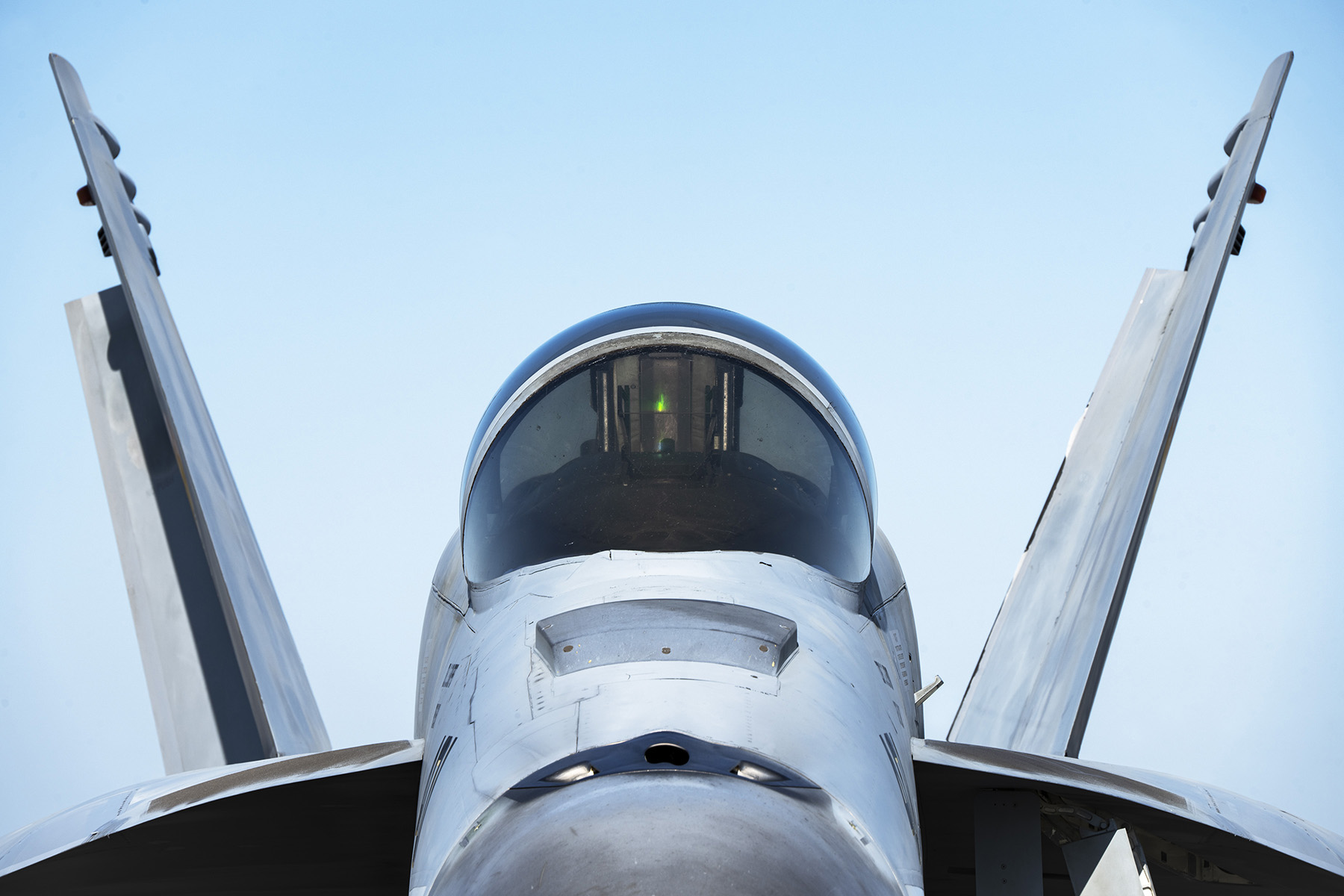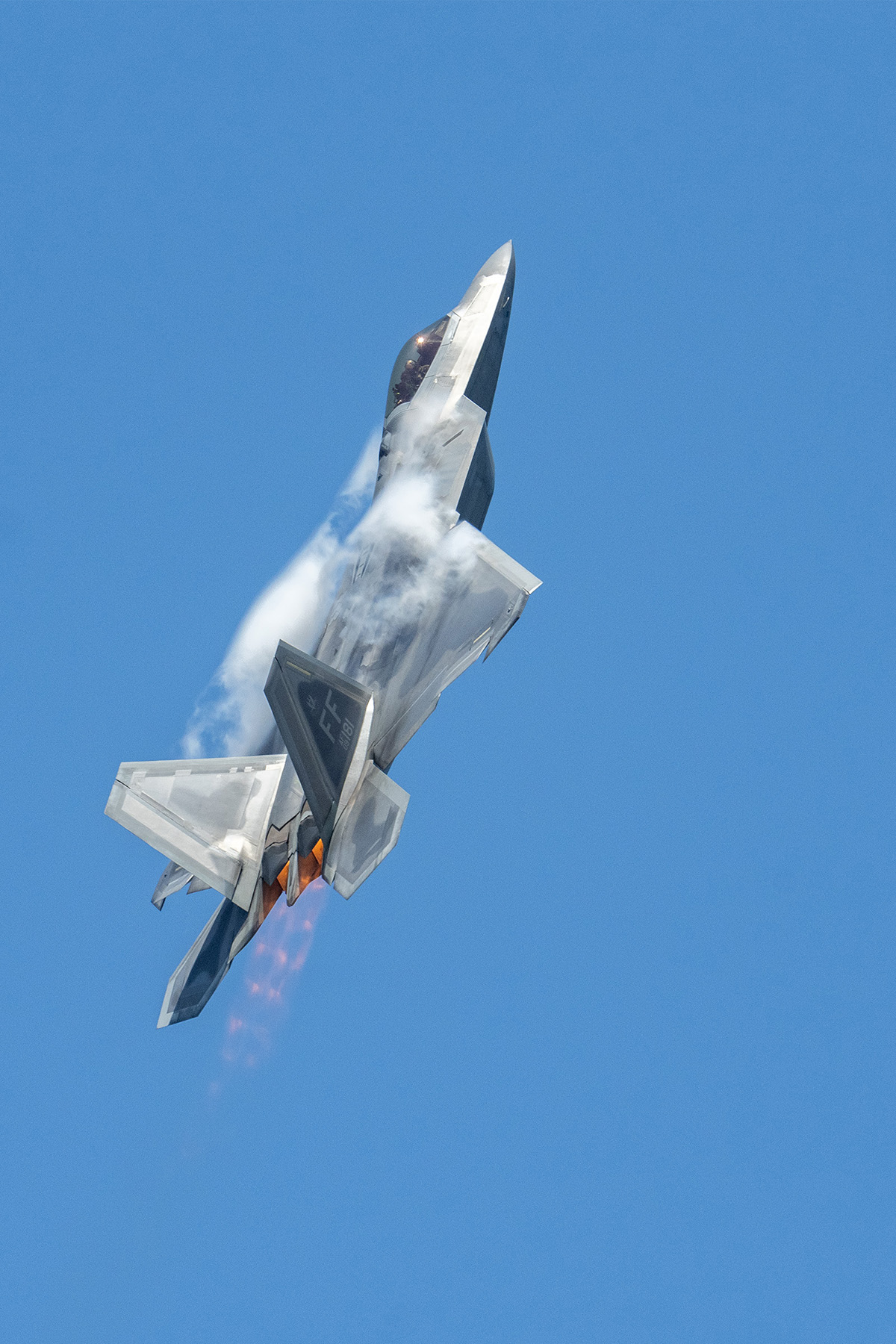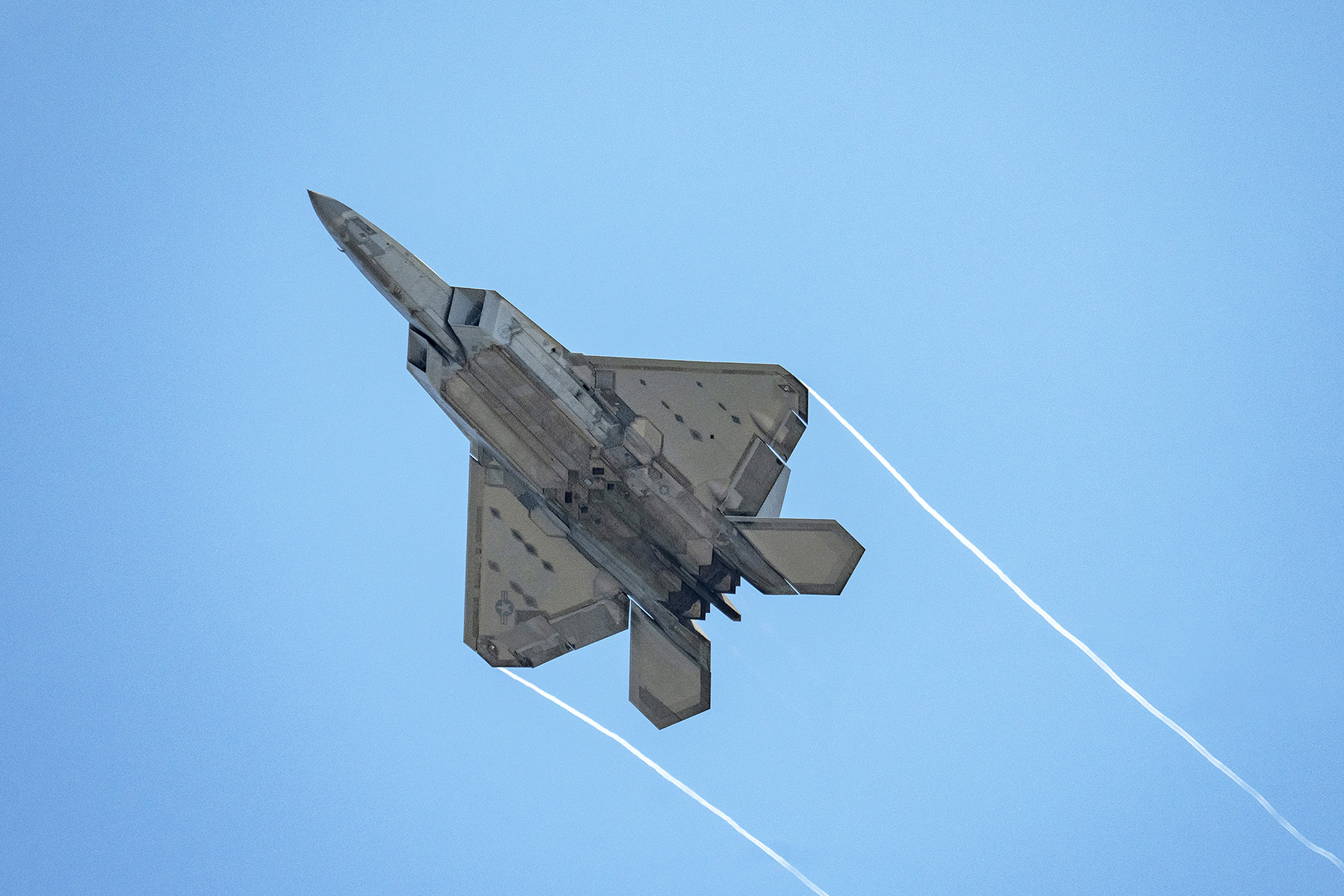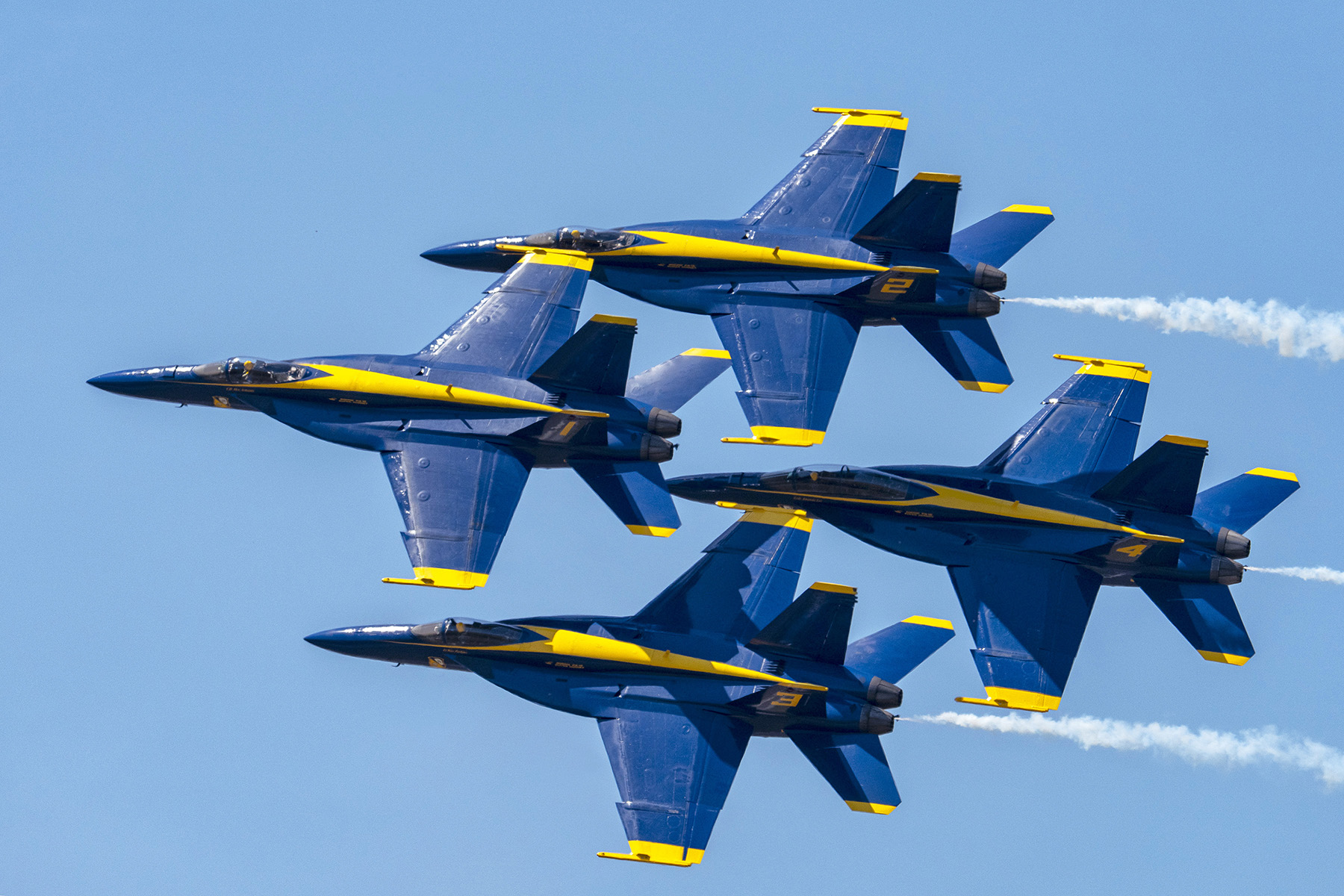The thrill of an airshow is truly unmatched. From the dazzling details of the aircraft to the precision of every maneuver and the vibrant trails of smoke, these breathtaking displays are a dream for photographers. Capturing them effectively requires skill, preparation, and the right airshow photography techniques. This article will equip you with the essential methods to document the action with stunning results.
By Guest Contributors Ken Hubbard and André Costantini
Airshow Photography Techniques Key Takeaways:
- Plan Ahead for the Best Shots: Arriving early and attending practice sessions can help you find the best angles and compositions.
- Use the Right Lens for Airshow Photography: Wide-angle lenses capture dramatic overhead shots, while ultra-telephoto lenses provide reach and stability for distant aircraft.
- Master Airshow Photography Settings: Adjust shutter speed, aperture, and ISO to achieve sharp, dynamic images, whether capturing vapor trails or propeller blur.
- Take Advantage of Weather Conditions: High humidity enhances vapor trails, and different lighting conditions throughout the day can provide unique opportunities.
- Experiment with Airshow Photography Techniques: Utilize leading lines, negative space, and static aircraft to create compelling images beyond just mid-air action.

Capturing these high-speed aerial acrobatics requires skill, patience, and the right lenses—whether it’s a Tamron 20-40mm F2.8 Di III VXD wide-angle lens for shots straight overhead or on the ground or an ultra-telephoto telephoto lens like the 50-400mm Di III VC VXD, 50-300mm Di III VC VXD or 150-500mm Di III VC VXD for ultimate reach and versatility.
From early morning sneak peeks that offer you private time with the jets, to jaw-dropping performances and evening pyrotechnics, we have the airshow photography techniques you need to show off the Blue Hornets, Blue Angels, Thunderbirds, or whatever air demo squadron is taking to the skies at your next airshow.
Best Camera Settings for Airshow Photography

To capture the fast-paced action of an airshow, understanding your camera settings is essential. Adjusting your shutter speed, aperture, and ISO will help you freeze motion, create a sense of speed, and maintain sharpness in various lighting conditions. Exposure compensation can also be a valuable tool, allowing you to adjust for bright skies or backlit aircraft to ensure optimal exposure.
- Fast Shutter Speed: For fast-moving jets, like all moving subjects, high shutter speeds of at least 1/1000 sec is needed to freeze action. For propeller-driven aircraft, a slower shutter speed of 1/250 sec or lower will create motion blur in the propellers for a natural effect.
- Aperture: Keep it between f/5.6 and f/8 for sharpness and depth of field. Using Aperture Priority mode can be advantageous, as it lets you set your desired aperture while the camera automatically adjusts the shutter speed. This ensures proper exposure while maintaining control over depth of field, making it easier to adapt to changing lighting conditions and aircraft speeds.
- ISO: Keep ISO as low as possible (ISO 100-400) for noise-free images, adjusting for lighting conditions as needed.
- Exposure Compensation: Use exposure compensation (+/- EV) to adjust for bright backgrounds or harsh lighting conditions, ensuring well-balanced images.
- Best Autofocus Mode for Ground to Air Airshow Photography: Use Continuous Autofocus to track moving aircraft. Selecting the right focus points is crucial; using a zone or dynamic autofocus area can help maintain sharpness on fast-moving jets while avoiding background distractions. However, in situations where precise control over focus is needed—such as capturing a single aircraft in a busy sky or isolating a static plane from clutter—using Single Point AF may be more beneficial to ensure the sharpest focus on your intended subject.
- Shooting Mode: Burst Mode helps capture precise moments of aerial action.
Best Lens for Airshow Photography

Selecting the right lens for airshow photography can make a significant difference in the image quality and detail of your images. Whether you’re photographing static displays, mid-air formations, or high-speed aerobatics, choosing the correct focal length is one of the essential airshow photography techniques that will enhance your shots.
Wide-Angle
Great for static aircraft, low-flying formations, and environmental shots.
The Tamron 20-40mm F/2.8 Di III VXD lens is perfect for capturing the atmosphere of an airshow, providing sweeping views of static displays, parked aircraft, and the crowd. This focal range allows you to create immersive environmental shots that showcase the grandeur of the event. It’s also useful for low-flying formations, as it allows you to include elements of the airfield in the frame while keeping aircraft in sharp focus.
Additionally, its wide aperture capabilities make it ideal for shooting in lower-light conditions, such as during evening performances or inside hangars.
Tele to Ultra-Telephoto
Excellent for mid-range shots of individual jets and formations to extreme close-ups, banking maneuvers, and vapor trails.
The Tamron 50-400mm F/4.5-6.3 Di III VC VXD, 50-300mm F/4.5-6.3 Di III VC VXD, and the 150-500mm F/5-6.7 Di III VC VXD lenses provide incredible versatility, allowing you to zoom in on aircraft mid-flight. The 50-400mm and 50-300mm reach the tele range while still offering a wide enough focal length for formation shots and takeoff sequences.
The extended reach of these lenses makes them particularly valuable for capturing the details of aircraft at varying distances, from mid-range aerobatic performances to close-up action of jets on the runway. With telephoto compression, they help create visually dynamic images by pulling the background closer, adding depth and drama to your shots.
Additionally, image stabilization in telephoto lenses is extremely beneficial at air shows, helping to reduce motion blur caused by hand-holding the camera while tracking fast-moving aircraft, ensuring sharper and clearer shots.
Airshow Photography Techniques and Tips

Capturing stunning airshow images involves more than just pointing your camera at the sky. By considering composition, vantage points, and environmental conditions, you can create dynamic and visually striking photographs. Below are 11 key airshow photography techniques to enhance your shots.
TIP 1: Experiment with Composition
Consider different angles, such as shooting from a low perspective to make aircraft appear more imposing or utilizing dramatic sky textures as a backdrop. Experimenting with composition ensures your shots stand out, even in less-than-ideal lighting. Utilize negative space creatively to compensate for difficult lighting conditions.
TIP 2: Head to Practice Sessions
Attending practice runs allows you to get familiar with the aircraft’s movements before the main show. This gives you the chance to perfect your timing, test different lenses, and capture clear images without the distractions of a crowded event. These sessions offer unique, less crowded opportunities for capturing dynamic moments and detailed storytelling elements, making them an excellent time to refine your airshow photography techniques.
TIP 3: Incorporate an Airfield’s Uniqueness
Each location provides a distinct setting—whether it’s a scenic mountain range, city skyline, or a control tower in the background. Using these elements adds depth and interest to your airshow photography, making each event feel unique. Use local landmarks or mountain backdrops to add depth to your shots.
TIP 4: Seek Out Static Aircraft
Grounded planes provide fantastic opportunities for close-up details, reflections, and unique compositions. Play with angles and focal lengths to create artistic images that highlight the craftsmanship of these incredible machines. Parked planes make for great abstract compositions, emphasizing lines, shadows, and reflections.

TIP 5: Don’t Stick to the Show’s Center
Moving to the outer edges of the airfield allows you to capture aircraft as they bank and turn, offering more dramatic action shots. This position also helps avoid the crowds, giving you an unobstructed view of the performance. Shooting from the far ends of the airfield provides more dramatic banking shots of jets.
TIP 6: Highlight Your Favorite Jets
If there’s a particular aircraft or team you’re excited about, focus on capturing multiple shots of them throughout the event. Try different perspectives, including head-on shots during takeoff or tight telephoto shots showcasing intricate details. A telephoto lens ensures sharp, detailed images while patience allows you to wait for ideal lighting and sky conditions.
TIP 7: Pay Close Attention to the Announcers
Airshow commentators provide crucial insights about upcoming maneuvers, giving you time to adjust settings and prepare for key moments. Listening closely ensures you never miss an exciting flyby or signature stunt. Their knowledge of aircraft movements helps with pre-planning shots, choosing the right focal length, and applying effective airshow photography techniques to capture the best possible images.
TIP 8: Flip Your Camera for Ascending Shots
When aircraft soar into the sky, turning your camera vertically helps reduce unnecessary negative space. This orientation enhances the feeling of motion and direction, making your shots feel more immersive. A vertical orientation enhances composition and reduces unnecessary negative space.
TIP 9: Use Leading Lines and Opposing Movements
Smoke trails, runways, and even the positioning of multiple aircraft can serve as leading lines, drawing attention to the subject. Look for contrasting movements, such as a jet climbing while a parachutist descends, to create striking compositions. Smoke trails can guide the eye and create striking visual contrasts, such as a jet ascending while a parachutist descends.
TIP 10. Master Prop Planes
Propeller-driven planes require different airshow photography techniques than jets. To create a motion blur effect on the propellers, slow your shutter speed to about 1/250 sec. This will make your photos feel more dynamic and prevent the aircraft from looking frozen in time. Mastering slow shutter speeds (1/250 sec or lower) captures propeller blur for a true sense of movement.
TIP 11: Capitalize on Hot, Humid Days
High humidity is a prime condition for capturing spectacular vapor effects. Fast-moving fighter jets create dramatic vapor clouds when the air is very humid. Checking local humidity forecasts before the show can help you get ready for these exciting photo opportunities. High humidity (80% or higher) enhances vapor effects, making for dramatic action shots.
What to Bring to an Airshow Event

In addition to understanding airshow photography techniques, being properly equipped can make all the difference in capturing high-quality images while staying comfortable throughout the event. Here are some essential items to bring:
- Camera Batteries & Memory Cards: Airshows are long events with plenty of photo opportunities. Bring extra batteries and high-capacity memory cards to avoid running out of power or storage.
- Telephoto Lens: A lens with a long focal range, such as a 50-400mm or 150-500mm, helps capture detailed shots of aircraft at a distance.
- Wide-Angle Lens: Useful for photographing static displays, crowds, and environmental shots that showcase the atmosphere of the event.
- Monopod or Tripod: A monopod provides stability while allowing mobility when tracking fast-moving planes, while a tripod can be useful for static shots or night photography.
- Polarizing Filter: Helps reduce glare and improve contrast, especially when shooting against bright skies.
- Lens Hood: Protects against lens flare and shields the front element from stray light.
- Comfortable Clothing & Hat: Airshows are often held outdoors in hot conditions, so dressing comfortably and wearing a hat can help keep you cool.
- Sunscreen & Sunglasses: Protect yourself from prolonged sun exposure during the event.
- Ear Protection: Some aircraft, particularly fighter jets, produce extreme noise levels, so earplugs or noise-canceling headphones are recommended.
- Folding Chair or Blanket: If allowed, bringing a chair or blanket makes waiting between performances more comfortable.
- Weather Protection: Depending on the forecast, pack rain gear, a lightweight jacket, or even a cooling towel for hot days. A light jacket for evenings is recommended.
- Water & Snacks: Staying hydrated and having snacks on hand will help you maintain energy levels throughout the event.
Final Thoughts on This Guide to Airshow Photography Techniques
Aviation photography is both thrilling and challenging, requiring preparation, the right gear, and a keen eye for composition. From early morning setups to fast aerial shows and nighttime fireworks, each moment gives a chance to capture the energy and skill of flight.
Trying different airshow photography techniques can help you take great photos. Experimenting with your approach will improve your skills and these tips will provide a great start to your airshow photography journey.
Watch these airshow tips in action.
Tamron will be at Sun ‘n Fun Aerospace Expo!
See us at Sun ‘n Fun 2026, borrow a lens, and enter the photo contest! Get all the details at the Tamron tent next to the Preferred Photography Area.



